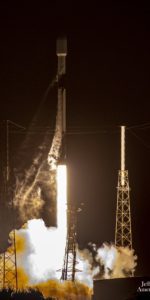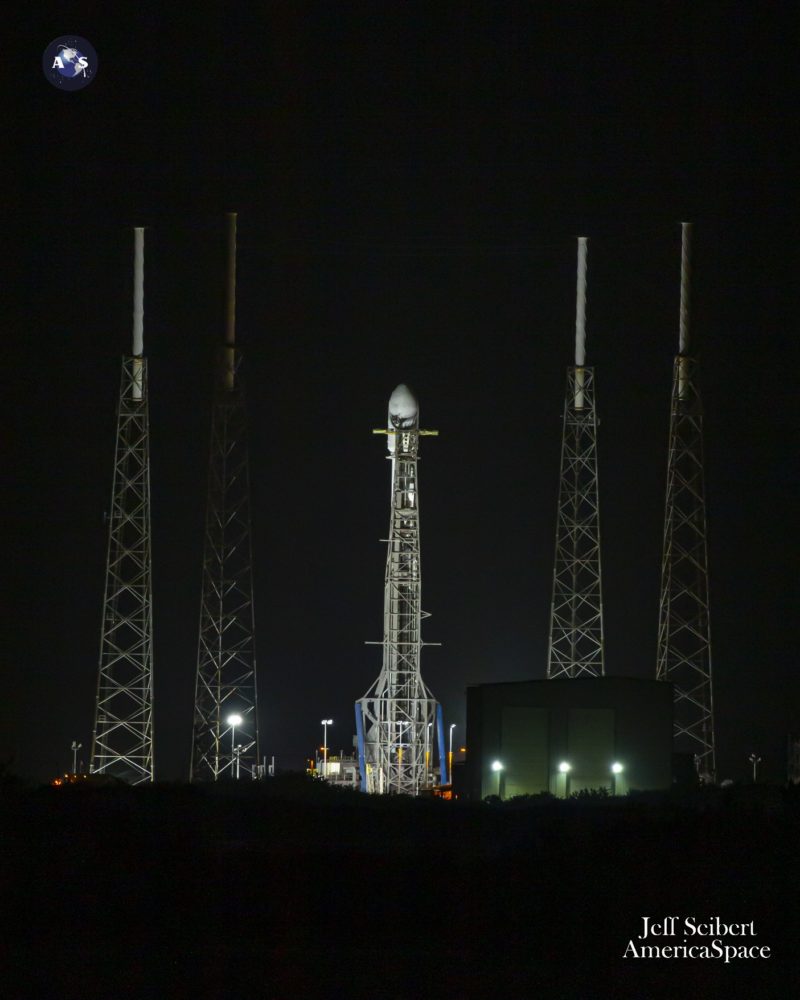
SpaceX will wait a little longer for its 100th Falcon 9 launch and its 100th successful Falcon 9 mission, following Monday night’s second scrub in a row for a record-setting booster core and the movement of NASA’s CRS-21 cargo flight to the International Space Station (ISS) to no earlier than 5 December. “Now targeting Tuesday, November 24 at 9:13 p.m. EST for Falcon 9’s launch of Starlink,” the Hawthorne, Calif.-based launch provider tweeted, “when conditions in the recovery area should improve.”
FOLLOW AmericaSpace’s LIVE Launch Tracker HERE!
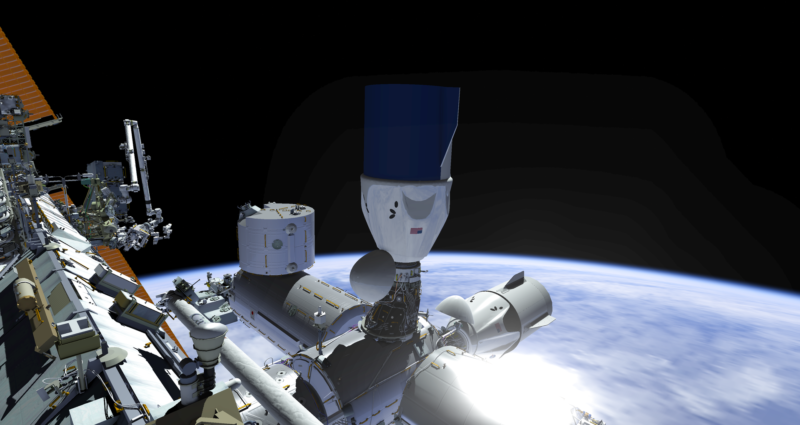
Elsewhere, a Flight Readiness Review (FRR) for CRS-21—SpaceX’s first mission under the second-phase Commercial Resupply Services (CRS2) contract with NASA—was satisfactorily concluded on Monday, allowing a definitive “Go for Launch” at 11:39 a.m. EST on 5 December. An on-time launch will produce a docking at the ISS the following day, marking the shortest rendezvous profile ever followed by a cargo-carrying Dragon.
Following Saturday morning’s spectacular launch of the Sentinel-6A ocean-monitoring satellite, named in honor of the late Dr. Michael Freilich, former head of NASA’s Earth Science Division, the Starlink mission was originally targeted from Space Launch Complex (SLC)-40 at Cape Canaveral Air Force Station, Fla., late Sunday night.
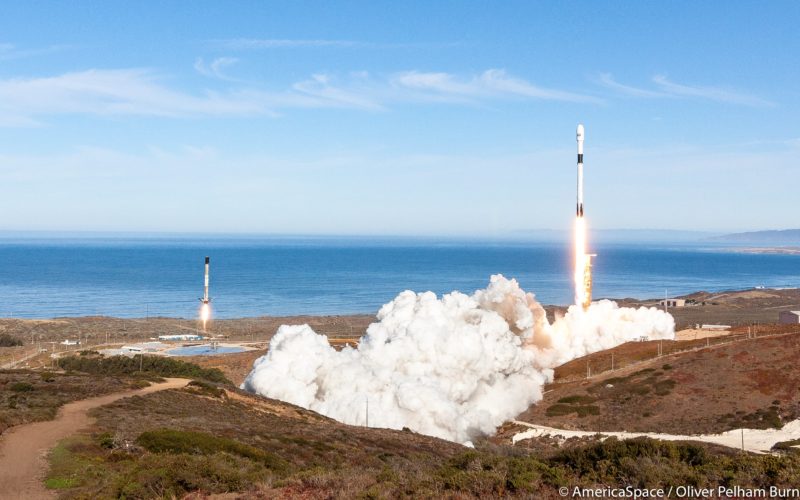
In readiness for its opening launch attempt, a smooth Static Fire Test of the nine Merlin 1D+ first-stage engines on the long-serving B1049 core was conducted on Saturday. But Sunday’s attempt was scrubbed in what SpaceX described as a need “to complete data reviews” and keep an eye on recovery weather, as the safe return of B1049 from what will be its record-setting seventh launch is given important priority.
Monday night’s launch attempt proved similarly afflicted. Despite an 80-percent chance of acceptable weather at the launch site on both Monday and Tuesday, conditions downrange in the Atlantic Ocean—where the Autonomous Spaceport Drone Ship (ASDS), “Of Course I Still Love You”, awaits about 390 miles (630 km) offshore—were considerably more marginal. It marked one of relatively few occasions in which SpaceX has prioritized the safe return of a booster as a deciding factor in scrubbing a launch.
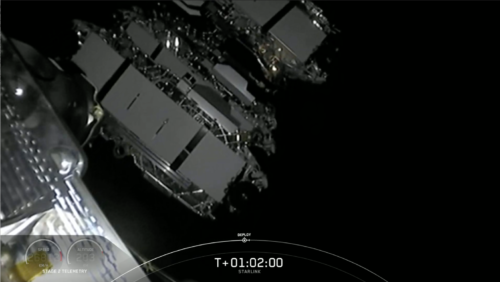
Of course, Starlink is an in-house SpaceX program and on commercial or government launches the safe return of the booster historically has not been so prioritized. That said, as confidence in the reusability of the Falcon 9 fleet continues to grow, the safe return of the Crew-1 booster and its intended future use for Crew-2 formed part of the decision to move its launch date back a day from 14 November.
First flown in September 2018 to deliver the heavyweight Telstar-18V communications satellite towards geostationary altitude, B1049 next saw service to deploy the last ten-strong “batch” of Iridium NEXT global mobile communications satellites in January 2019. It went on to support no fewer than four Starlink missions between May 2019 and August 2020.
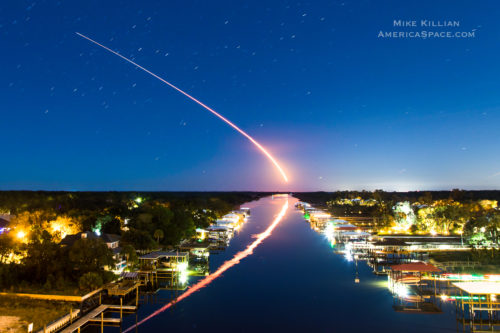
And tonight’s launch is expected to make it the first Falcon 9 core to fly as many as five batches of Starlinks. Including tonight’s 60-strong load, B1049 will have single-handedly delivered 298 of these internet communications satellites into space, about 30 percent of the total put into low-Earth orbit to date.
Assuming Starlink flies as planned at 9:13 p.m. EST Tuesday, it will mark the 100th launch of a Falcon 9 booster since the vehicle’s maiden flight, way back in June 2010. But it will not be the Falcon 9’s 100th “successful” flight, since one mission—the ill-fated launch of the CRS-7 Dragon—was lost during first-stage ascent in June 2015. As a result, it will be CRS-21 on 5 December which looks set to launch (and hopefully complete) the 100th fully successful Falcon 9 mission.
Weather conditions for tonight’s Starlink launch currently stand at 80-percent-favorable for an on-time liftoff, although SpaceX will be paying keen attention to the recovery zone. “Winds are expected to ease slightly Tuesday, as the flow becomes more easterly,” noted the 45th Weather Squadron in its Monday update. “While this may bring a few additional clouds and possibly an isolated shower towards the coast, overall moisture remains limited. Thus, the primary launch weather concerns for a Tuesday evening attempt are liftoff winds and the Cumulus Cloud Rule.”
In the meantime, CRS-21 moves a few days to the right, having been originally targeted to fly from historic Pad 39A at the Kennedy Space Center (KSC) as early as 2 December. The slippage to the 5th will enable “additional time to evaluate flight data from Crew-1,” NASA explained, “and close out certification work ahead of this first flight of the cargo version of Dragon-2.”
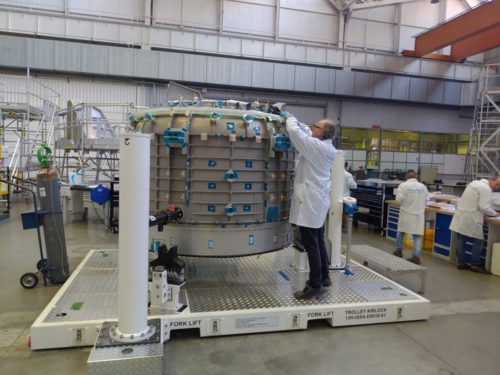
With launch expected to be aboard the B1058 core—first used earlier this year to loft Dragon Endeavour crewmen Doug Hurley and Bob Behnken—it is expected that the CRS-21 vehicle will approach and execute a docking at International Docking Adapter (IDA)-3 on the space-facing (or “zenith”) port of the station’s Harmony node at 11:30 a.m. EST 6 December. This rendezvous profile will be the shortest ever achieved by an uncrewed U.S. visiting vehicle and the first next-day docking by a cargo-carrying Dragon.
And the core expected to fly CRS-21 will be making its fourth flight, having previously launched Demo-2 last May and more recently South Korea’s ANASIS-II military communications satellite in July and a batch of Starlinks just last month. In flying ANASIS-II only 51 days after it launched Hurley and Behnken, B1058 currently holds the record for the shortest interval between two flights by a single Falcon 9 core.





